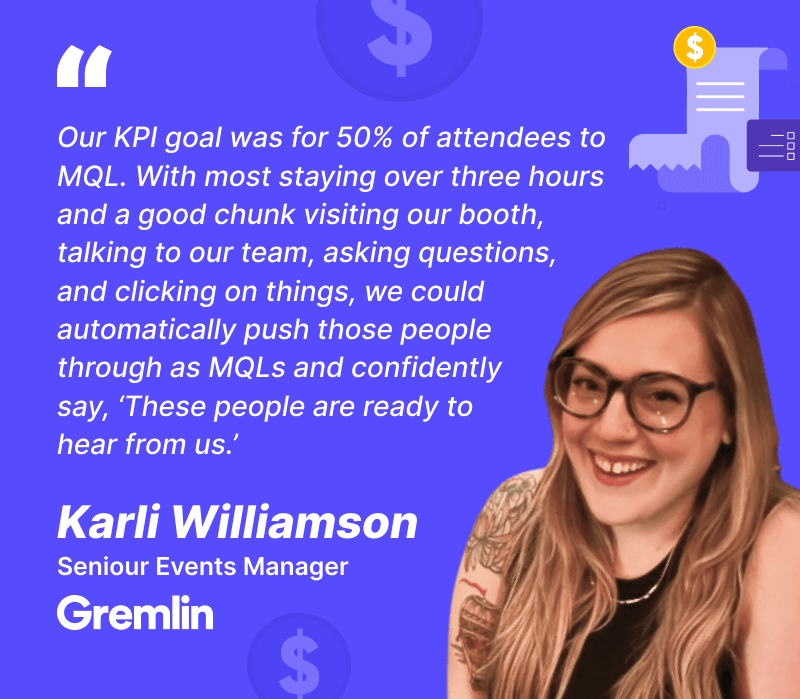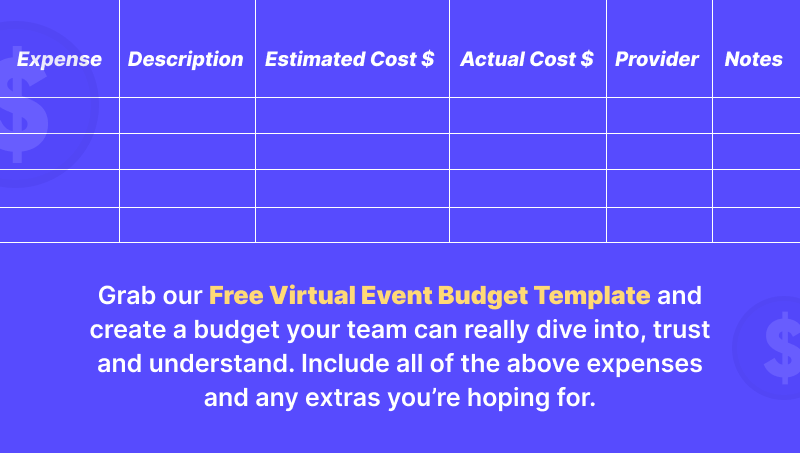Create Your Virtual Event Budget in 5 Simple Steps [Plus Free Template]

Maximize Your Marketing ROI
Join 10,000 other marketers already getting the best tips on running engaging events that boost pipeline and create raving fans.
No venue. No travel. No catering. Event marketers could easily be fooled into thinking not all that much goes into creating a virtual event budget.
But the truth is, there’s a lot to think about when planning a virtual event. And much of it comes with a price tag.
Whether it’s figuring out how much budget you need, coming up with ways to secure buy-in, or deciding exactly how to spend your virtual event budget — we’ve got you covered.
This simple 5-step guide will help you create a healthy virtual event budget, without cutting corners on the attendee experience.
Ready? Let’s get started!
👋 Check out our handy (and totally free!) Virtual Event Budget Template as a starting point to nail your event planning. You can download this Excel or copy this Google Sheet. Enjoy!
Step #1: Nail down the goal and scope of your event
Start at the beginning. What does your virtual event need to achieve? And how many people will be there?
As with an in-person event, size matters when it comes to planning your virtual event budget. First, figure out your target attendee registration goal. Then, calculate a rough percentage of how many people you think will actually attend.
Of course, the size of your event will likely depend on what role the event will play in your overall marketing strategy and how you plan to measure your success.
If you’re hosting a live webinar to boost brand awareness, how many attendees do you need and what event key performance indicators (KPIs) will you use to measure your results?
If you’re looking to accelerate the pipeline with a select group of key accounts, which metrics should you focus on?
In the former scenario, registrations, attendance, and engagement score might be a positive signal that you're generating awareness with the right audience and that they're digging your event content.
But in the latter, you may need to go a step further to grab the needle-moving data that helps your sales team move conversations forward after the event.
Step #2: Set your virtual event KPIs
Whether you’re hosting a large-scale brand-building event or a VIP-only virtual summit, you’ll want to pinpoint the right key performance indicators (aka, KPIs) as you plan your virtual event budget.
This will help you secure the internal buy-in you need because you’ll know exactly what outcomes your event will deliver.
Here are some common event KPIs that can help prove ROI:
- Net New Pipeline
- Influenced Pipeline
- Attendee Engagement Score
Once you’re clear on the outcomes you want to achieve, it’s easier to come up with a sensible virtual event budget to help smash those goals.

Step #2: Define your pricing structure
Once you’ve got your event goals and KPIs narrowed down, you’ll need to make sure you have a clear and attractive pricing strategy.
As with an in-person event, there are many ways to drive revenue at your virtual events, including:
- Sponsor and exhibitor packages
- VIP experiences
- Swag sales
- And more!
Of course, if you’re using events as part of a greater account-based marketing (ABM) strategy, you might be more concerned with the impact on the pipeline vs. any actual sales made the day of.
No matter what your event revenue strategy is, be sure to do your research. Attendees and sponsors are savvy. When they see a high-value offer, they’ll know it.
Step #3: Set a maximum budget
Realistically, how much virtual event budget are you likely to secure?
No wishful thinking. No underselling. Stick to the facts.
How much are you going to get? Set an amount and work back from it.
Then ask yourself:
Will my maximum budget be enough to achieve my virtual event KPIs?
If not, you may need to realign internally.
If you ace the pitch and get more budget, awesome. But just in case, be sure to plan for everything to fit into the realistic budget first to make sure all your core bases are covered.
At this stage of your virtual event planning, look at any added extras as a juicy, nice-to-have bonus once the core of your event is covered.
Step #4: Prep your virtual event expense log
Every event needs a little cash injection to get it off the ground.
And chances are if you’re asking the folks at the top for a big chunk of the budget upfront they’re going to want to know two things first:
- What are you spending it on?
- What are we getting in return?
Let’s tackle the first question head-on by getting clear on the top six virtual event line item expenses you’re likely to see.
1. Marketing and gifting: Hitting your attendee goal is going to depend big time on the amount of marketing and advertising you’re able to do for your event.
Whether it’s paid social or high-octane public relations, you’ll want to make sure you’ve got enough budget to drive the attendance you need.
Here are a few core marketing costs to consider:
- Social media ads
- Pay-per-click (PPC) ads
- Email marketing
- Landing page or microsite development
- Press & PR opportunities
And of course, swag is another major part of promoting your event.
If you’re running a larger event, you might have a swag bag for all attendees. If you’re going for a smaller, more targeted setup, you might be planning to make more of an experience-driven gifting play.
In either case, you’ll want to set a per attendee cost limit to make sure you’re able to deliver wow-worthy gifts without breaking the budget.
2. Platform: Start with the virtual equivalent of your in-person venue — the platform.
There are a few key things to consider when evaluating the best virtual event technology for your needs:
- Are there dedicated breakout rooms for networking?
- Can you run multiple tracks?
- Do the engagement features really rock?
- Are there demo and sponsorship booths available?
- Is it a white-label solution with custom branding capabilities?
- What third-party integrations are offered?
- What pre and post-event data can it track?
- What support does it offer?
- Can it also support hybrid events?
As important as rockstar features are, you also need a pricing plan that works for you (not against you).
💰 For optimal ROI, choose a virtual conference platform that structures pricing around attendees, not registrants. That way you’re not paying for people that don’t actually attend your events.
3. Speakers: As with an in-person event, content matters. You’re going to need a solid speaker budget to keep the audience engaged and excited. Ask yourself: How many speakers do you need? What are their fee ranges? Do you need them to create any extra content for VIP sessions? 💰 There are many variables with speakers and fees can range from totally free, right up to $100K+. Be sure to balance cost with content, name recognition, and potential outcomes.
4. Entertainment: Whether you’re booking a band, organizing a workshop, playing a movie, or curating a digital tour — you need entertainment to liven up the event, generate wow factor, and make your event truly memorable.
💰 As with speakers, entertainment costs vary. DIY entertainment can cost you nothing, but throw in a virtual wine-tasting and you could end up splashing $75 per attendee.
5. Virtual event production: Whether it’s mics and cameras for your virtual speakers or a video production company for your on-demand content, don’t underestimate how much your virtual event relies on nailing this part of the budget.
💰 When you’re on a budget for your virtual event, it’s handy to have a platform with video production capabilities at your disposal. 😉
6. Staffing: Going virtual means you minimize the staff needed for your event. But although you can prep content and registrations before the event, you’ll still need moderators, demo leaders, managers, technicians and sales reps live on the day.
💰 The more supportive your virtual event platform, the less staff you’ll need. Always ask your platform partner how much support you can expect on the day.

Step #5: Get buy-in
With your core expense areas pinned down, now it’s on to the next $10K question when planning your virtual event budget:
What are we getting in return?
Or, in C-suite lingo: What’s our virtual event ROI?
For better or worse, non-marketers often see events as a money drain. So let’s take this problem and flip it on its head, shall we?
One quick way to get buy-in for your virtual event budget is to highlight the cost-saving, revenue-driving benefits of virtual events as compared to in-person events.
Start with these three massive benefits:
- Reduced event expenses: Drop the hefty catering, staffing, branding, and venue expenses. A virtual setup lets you pull off an epic event with lower event costs and higher ROI. 🤩
- Increased attendee count: Open your virtual doors to way more attendees by removing barriers to entry, think: global access, no travel costs, and no Covid risks.
- Maximum pipeline impact: Whether the goal is influenced pipeline, net new pipeline, or velocity through pipeline, be prepared to show your execs exactly how the right virtual event budget will help you drive revenue.
Now is the time to paint a clear picture of the potential pipeline value of your virtual event. Circle back to your initial event goals, determine the data you’ll track, and lay out any projections you hope to achieve.
Depending on your event goal and attribution model, this could be anything from total live registrations, attendance rate, number of qualified leads, new pipeline, customer retention, and more.
From budget to buy-in: A virtual event budget the whole team can get behind ❤️
Let’s be honest, most of us don’t love managing a budget.
But when it comes to event marketing, the right virtual event budget can help you show off just how awesome you and your event ideas really are.
As with all things event marketing, you’ve got to hope for the best and plan for the worst when it comes to creating a healthy virtual event budget. Make sure your bases are covered but don’t be afraid to dream big.
Remember, even a limited virtual event budget can produce revenue results beyond all expectations. Now get out there and get planning. You got this!

Transform Your Video Marketing with AI
Stay In Touch
Platform
Resources
© 2025 Copyright Goldcast, Inc. All rights reserved.





 Upcoming Events
Upcoming Events Event Series
Event Series On-Demand Events
On-Demand Events

